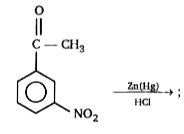Alkenes on treating with O3 and then the product on reduction may give
CO2 and water
aldehydes
ketones
none of the above
The correct Answer is:B, C
To solve the question regarding the treatment of alkenes with ozone (O₃) and the products obtained after reduction, we can follow these steps:
1. Identify the Reaction:
Alkenes react with ozone (O₃) in a process known as ozonolysis. This reaction involves the cleavage of the carbon-carbon double bond (C=C) and the formation of an ozonide intermediate.
2. Consider a Terminal Alkene:
For this example, let’s take a simple terminal alkene, such as propene (CH₃-CH=CH₂).
3. Ozonolysis Reaction:
When propene reacts with ozone, the double bond is cleaved, and an ozonide is formed. The reaction can be represented as:
CH₃−CH=CH₂+O₃→ozonide
4. Formation of Ozonide:
The ozonide is a cyclic compound that contains an oxygen-oxygen bond. For propene, the ozonide will have the structure:
CH₃−CH(O)−O−CH₂
5. Reduction of Ozonide:
The ozonide is then subjected to reduction, typically using zinc (Zn) in water (H₂O). This step breaks the ozonide and leads to the formation of carbonyl compounds.
6. Products of Reduction:
After reduction, the ozonide will yield:
- Acetone (CH₃-CO-CH₃), which is a ketone.
- Formaldehyde (HCHO), which is an aldehyde.
7. Conclusion:
Therefore, the products obtained from the ozonolysis of alkenes followed by reduction are aldehydes and ketones.
Final Answer:
Alkenes on treating with O₃ and then the product on reduction may give aldehydes and ketones.
Alkenes react with ozone (O₃) in a process known as ozonolysis. This reaction involves the cleavage of the carbon-carbon double bond (C=C) and the formation of an ozonide intermediate.
For this example, let’s take a simple terminal alkene, such as propene (CH₃-CH=CH₂).
When propene reacts with ozone, the double bond is cleaved, and an ozonide is formed. The reaction can be represented as:
CH₃−CH=CH₂+O₃→ozonide
The ozonide is a cyclic compound that contains an oxygen-oxygen bond. For propene, the ozonide will have the structure:
CH₃−CH(O)−O−CH₂
The ozonide is then subjected to reduction, typically using zinc (Zn) in water (H₂O). This step breaks the ozonide and leads to the formation of carbonyl compounds.
After reduction, the ozonide will yield:
- Acetone (CH₃-CO-CH₃), which is a ketone.
- Formaldehyde (HCHO), which is an aldehyde.
Therefore, the products obtained from the ozonolysis of alkenes followed by reduction are aldehydes and ketones.
Alkenes on treating with O₃ and then the product on reduction may give aldehydes and ketones.
Similar Questions
Knowledge Check
When phenol is treated with CHCl3 and NaOH, the product formed is
AbenzaldehydeBsalicylaldehydeCsalicylic acidDbenzoic acid.When phenol is treated with CHCl3 and NaOH, the product formed is
AbenzaldehydeBsalicylaldehydeCsalicylic acidDbenzoic acid.When phenol is treated with CHCl3 and NaOH, the product formed is
AbenzaldehydeBsalicylaldehydeCsalicylic acidDbenzoic acid.
When phenol is treated with CHCl3 and NaOH, the product fromed is
View SolutionWhen SO3 is treated with D2O, the products are :
View Solutiono-Chloroaniline is treated with a mixture of NaNO2 and HCl and the product is reacted with cuprous bromide. The final product in the reaction will be
View SolutionHow many alkenes on catalytic hydrogenation give isopentane as a product (consider only structural isomers) ?
View Solution , Product of the Clemmensen reduction is :
, Product of the Clemmensen reduction is :
View Solution
